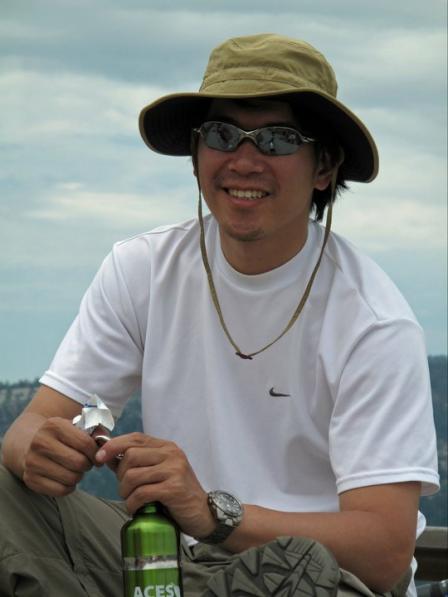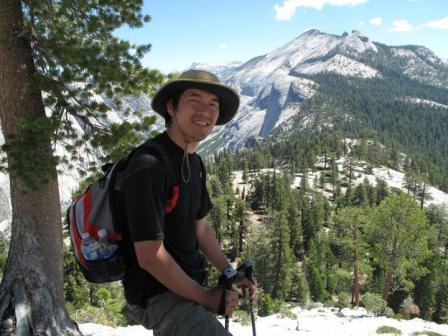Meet EPA Researcher John Lin, Ph.D.
EPA researcher John Lin assesses riparian ecosystems. Riparian areas—the area between land and a river or stream—provide critical ecosystem services such as fish habitats, livestock and wildlife forage, and water purification. As part of this work, he often collaborates with Native American tribes as they are both regulators and managers of their land.
 Meet EPA Researcher John Lin!When did you first know you wanted to be a scientist?
Meet EPA Researcher John Lin!When did you first know you wanted to be a scientist?
I have been interested in physics and mathematics since I was a little kid, and I continue to excel in these subjects. When I started to conduct research projects in graduate school, I knew I would enjoy being a scientist and pursuing knowledge to make a difference.
What is your background?
I have an undergraduate degree in surveying and a graduate degree in geodetic science from The Ohio State University. I also have a PhD from Cambridge University in polar studies. The common theme in these fields of study is remote sensing. I became interested in remote sensing applications when I took an undergraduate class about the interpretation of remote sensing data. This data helps researchers recognize features on the ground and understand how the effects of land use and land cover changes over time.
What do you like most about your research?
I get to work with and learn from scientists from various fields of expertise such as ecologists, soil scientists, hydrologists, biologists, and chemists. I also get to work with tribal members and learn about Traditional Ecological Knowledge (TEK). TEK reflects each tribe’s own set of knowledges and lived experiences and is critical to how tribes interact with their local environment. The traditional values and cultures of Alaska Native and American Indian people are what make these communities distinct. These different perspectives help me better understand complex ecosystem issues.
How does your science matter?
Tribal lands bring economic benefits to the tribes. Tribal members also value the cultural and spiritual connection with their land. One of the many goals of a tribe’s environmental and natural resource department is to maintain and restore functionality of watersheds. Disturbances—such as diversion dams, stormwater water discharge, construction, or channelization—occurring within a watershed, or adjacent to a stream corridor, may temporarily or permanently alter the functionality of the water body, as well as cultural and ecological interactions. I work on assessments that identify the drivers (vegetation, hydrology, soil and landform) of riparian ecosystem health. The trend of an ecosystem’s health can be improving towards properly functioning (ability to sustain a state of resiliency during high-flow event), or degrading towards functioning-at-risk or nonfunctional, or static (not getting better or worse). The assessments also check whether tribal environmental goals, including Clean Water Act objectives are being met. After an assessment is conducted, a tribe can determine what management changes need to be made to address environmental and ecological risk factors and maintain or return the water body to the proper functioning condition.
If you weren’t a scientist, what would you be doing?
I would probably be a sports coach. I enjoy teaching the specialized techniques in sports and the values that one needs to be successful are often learned through sports.
 John Lin hiking in Yosemite National ParkWhat advice would you give a student interested in a career in science?
John Lin hiking in Yosemite National ParkWhat advice would you give a student interested in a career in science?
Study what you love and it will open doors to opportunities you would have never thought of. When I first engaged in research on global sea level change in graduate school, it was not a very well-known subject. Eventually, it paved the path for me to conduct my current research and has allowed me to make a difference in the environment.
If you can have any superpower, what would you choose?
I would choose the ability to fly. I like looking at satellite and aerial imagery because I can see things well above earth. If I can fly I can go anywhere and look at the landscape of the world.
What do you think the coolest scientific discovery was and why?
Discovery of electromagnetic radiation wavelengths. The discovery of wavelengths other than visible light allows us to see things that otherwise would not be visible or possible.
If you could have dinner with any scientist, past or present, who would you choose?
I would like to have dinner with Marie Skłodowska Curie. She is an extraordinary scientist especially during her time. I admire her achievements while overcoming gender inequity and having a strong sense of her root identity.
Editor's Note: The opinions expressed herein are those of the researcher alone. EPA does not endorse the opinions or positions expressed.
